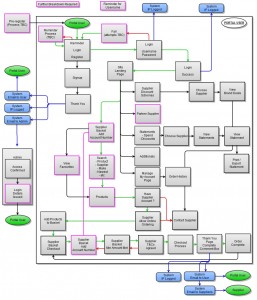In a previous post we talk about Wireframing for Websites in which we mention the use of a flow diagram to map out how a customer will walk through a website.
I am going to focus on this flow diagram process which allows you to detail each of the entry points on your website and then map the journey from that point through to where you want the customer to end up; whether that is in a sale, a lead, a signup for membership, an information download etc.
 The flow diagram can also be expanded to encompass processes that occur when a customer undertakes a specific action e.g. sign up to a newsletter or it can also be used to map out the messaging throughout the journey / website.
The flow diagram can also be expanded to encompass processes that occur when a customer undertakes a specific action e.g. sign up to a newsletter or it can also be used to map out the messaging throughout the journey / website.
An entry point or landing page can be any page a customer is directed to from a Search Engine, Social Media, Newsletter Campaign, Leaflet for example.
In 2013 we were selected to design, build and deliver an eCommerce Portal for a client which, due to the platform needing to contain commercially sensitive information, required some security around how the site was accessed. Part of this requirement was that the site should not be visible to Search Engines and could only be accessed from a link from another website where the user was already logged in.
We mapped out the journey on this occasion from a technical and process perspective. New users to the Portal would have to go through a manual signup process which, when approved, would give them full access to the Portal.
We produced a flow diagram for the front end and also one for the back end of the site. The products on the Portal would be initially set-up by our client but then be updated by the relevant supplier of each individual product. As such we also produced a flow diagram for the supplier journey on the site.
 The flow diagram we produced for the front end is to the left – with some minor elements amended for the confidentiality reasons. As you can see the flow diagram shows:
The flow diagram we produced for the front end is to the left – with some minor elements amended for the confidentiality reasons. As you can see the flow diagram shows:
– Signup and Login process
– User access to view Supplier offers
– User navigation through the buying process
– User access to account management and order history
– etc ..
This flow diagram has gone through a number of iterations following discussions / Emails between our client and Paramount. The end result being that 95% of the specification for the Portal had been planned ready for development.
We feel the importance of this step in the development of a website cannot be understated as it will ensure you explore all avenues of a website leading to the website providing the best experience for the intended customers / clients and the best chance of the website being a business success. Also the time invested at this stage reduces the overall development time and the chances of surprises half way through the project.
——————
Image courtesy of arztsamui / FreeDigitalPhotos.net

